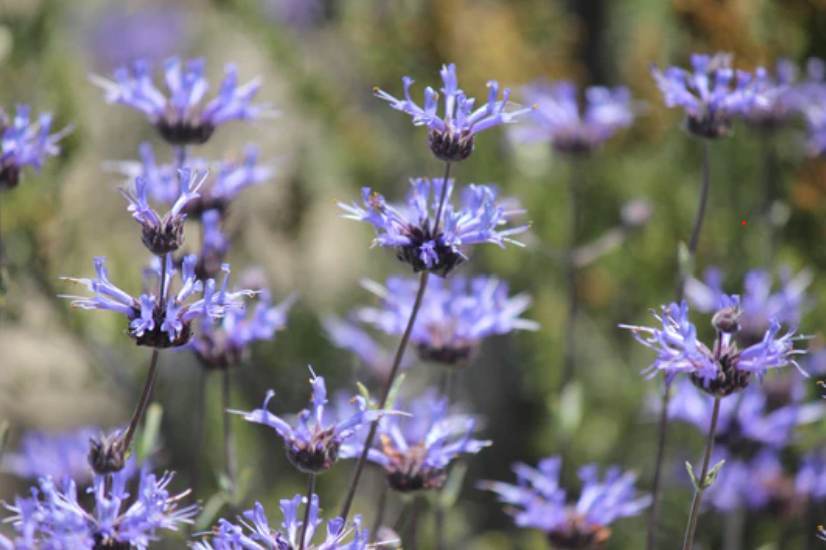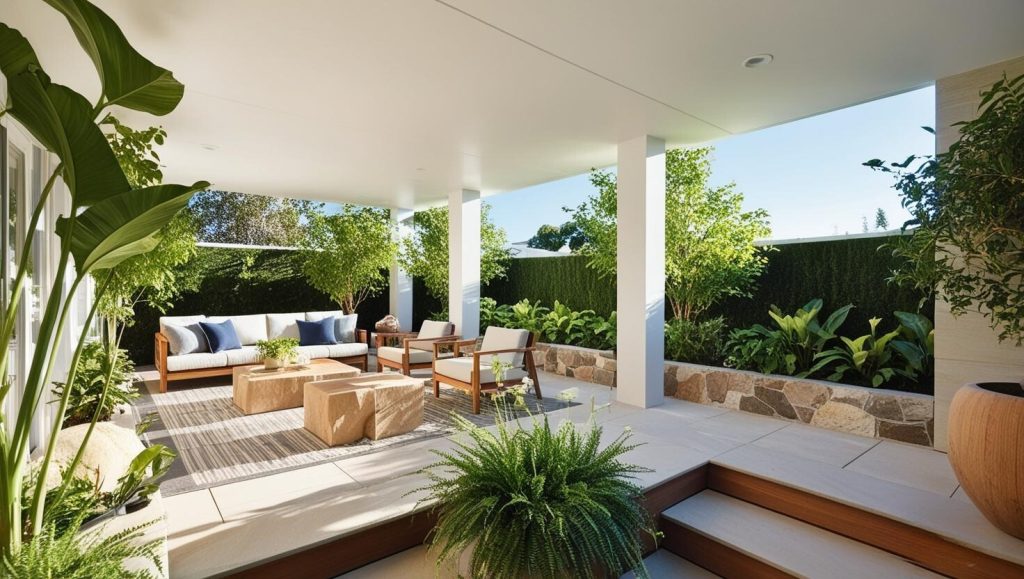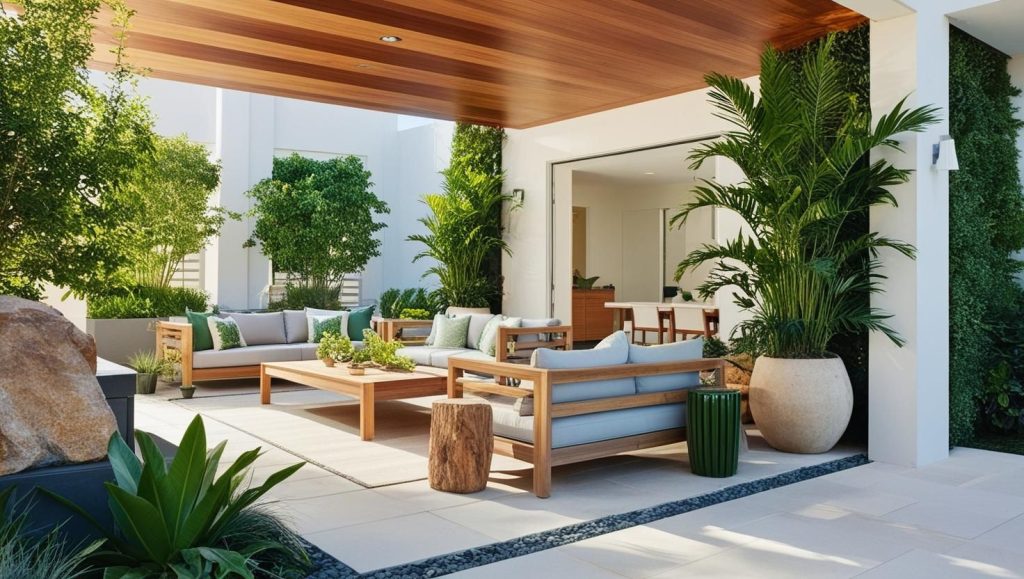
Biophilic design is revolutionizing home remodeling in San Diego and beyond. This innovative approach seamlessly integrates natural elements into your living spaces, creating a harmonious connection between your home and the environment. By incorporating biophilic principles into your remodel, you can transform your space into a sanctuary that enhances your well-being and fosters a deeper connection to nature.
Imagine waking up to the gentle sound of a water feature in your bedroom or working from home surrounded by lush greenery and natural light. These are just a few examples of how biophilic design can elevate your living experience. From large windows that maximize natural light to organic materials and textures, biophilic remodeling offers endless possibilities to create a refreshing and grounding space.
As a San Diego homeowner, you’re uniquely positioned to take advantage of the region’s beautiful natural surroundings. Biophilic design can help bring the outdoors inside, allowing you to enjoy the benefits of nature year-round.
But what exactly makes biophilic design so transformative? It’s more than just aesthetics—this thoughtful approach turns your home into a sanctuary that reduces stress, enhances well-being, and reconnects you to nature. Imagine a space where every detail—from the plants you nurture to the light that fills the room—works together to improve your quality of life.
Whether planning a whole home remodel or starting with smaller updates, biophilic design offers practical and beautiful ways to transform your living experience. Let’s dive into the principles, patterns, and ideas that can bring this inspiring design concept to life in your home.
Prefer Listening? Here’s the Podcast Version:
Biophilic design incorporates natural elements into built environments to enhance human well-being. This approach is grounded in specific principles that guide designers and architects in creating spaces that foster a connection with nature.
Biophilia refers to humans’ innate affinity for nature. It stems from our evolutionary history and deep-rooted need to connect with our natural surroundings. Biophilic design capitalizes on this connection, aiming to improve physical and mental health, productivity, and overall quality of life.
Biophilic design becomes crucial in modern urban settings where people spend significant time indoors. It helps reduce stress, enhance cognitive function, and boost mood by bringing nature’s restorative qualities into built spaces.
Incorporating biophilic elements can be as simple as adding plants or as complex as designing entire structures around natural forms and processes.
The six principles of biophilic design1 provide a framework for implementation:
These principles guide you in creating spaces that mimic nature’s beneficial aspects. They involve using natural materials, maximizing natural light, and incorporating organic shapes and patterns.
Biomorphic forms and patterns play a key role, reflecting shapes found in nature. That can include leaf-like ceiling patterns or tree-inspired column designs.

Biophilic design employs specific patterns to create nature-connected spaces:
You can combine these patterns to create rich, multisensory environments. The goal is to evoke the feeling of being in nature, even within enclosed spaces.
By thoughtfully applying these principles and patterns, you can transform any space into a biophilic haven that promotes well-being and connection with the natural world.

Biophilic design brings the outdoors inside, creating spaces that foster a connection with nature. This approach uses plants, water features, and natural materials to enhance well-being and create a more harmonious living environment.
Houseplants are an essential component of biophilic design. For beginners, start by selecting low-maintenance options like snake plants or pothos. Place larger plants in corners or as focal points, and use smaller ones on shelves or windowsills.
Consider creating a living wall for a bold statement. This vertical garden can serve as a natural air purifier and a stunning visual element.
If you’re not ready for live plants, consider botanical prints. These can add a touch of nature to your walls without the maintenance requirements.
Native San Diego Plants for Biophilic Design
For an authentic connection to the local ecosystem, consider incorporating San Diego native plants into your indoor spaces. The Cleveland Sage (Salvia clevelandii) thrives indoors and adds a wonderful aromatic element to your home. The Catalina Perfume (Ribes viburnifolium) works excellently as a hanging plant, while the Compact Rush (Juncus patens) can create striking vertical interest in well-lit corners.

The California Wild Grape (Vitis californica) adapts well to indoor conditions and can create beautiful trailing displays for lower-light areas. The Island Alum Root (Heuchera maxima) offers attractive foliage and can thrive in containers, making it perfect for shelves or tabletops. These native plants connect your space to the local environment and typically require less water and maintenance than non-native species.

When planning your indoor native plant garden, consider creating microclimates that mirror San Diego’s natural environments. Group coastal plants like Shaw’s Agave (Agave shawii) in areas with bright, indirect light and use Desert Mallow (Sphaeralcea ambigua) in spaces that receive more direct sunlight.

Seasonal Care for San Diego Native Plants
San Diego’s mild Mediterranean climate means your indoor native plants need minimal seasonal adjustments. In winter (November to March), watering frequency is reduced as most native plants enter a natural period of slower growth. During Santa Ana conditions, typically in fall, consider increasing humidity around your indoor plants with pebble trays or small humidifiers. Spring (March to May) is the ideal time to propagate or add new native plants to your indoor collection, as this aligns with their natural growth cycle. During the warm summer months, pay special attention to plants in south-facing windows, as they may need additional shade protection during peak afternoon hours.
Water elements bring a sense of tranquility to your space. Install a small indoor fountain in your entryway or living room. The sound of flowing water can create a calming atmosphere.
For a more subtle approach, consider a tabletop water feature. These compact designs can fit on desks or side tables, providing a soothing presence without dominating the room.
In larger spaces, you might explore the possibility of a wall-mounted waterfall. That can serve as a striking focal point while offering the benefits of moving water.
Incorporate natural materials like wood, stone, and bamboo into your remodel. Wooden flooring or exposed beams will bring warmth and organic texture to your space.
Consider stone countertops or accent walls to add a rugged, natural element. Cork is another versatile material that can be used for flooring or wall coverings, providing both visual interest and acoustic benefits.
Introduce natural textures through your choice of fabrics and finishes. Opt for linen curtains, wool rugs, or jute baskets to add layers of organic texture to your rooms.

Effective use of light and space is crucial in biophilic design. Incorporating natural illumination and creating open areas can enhance well-being and productivity in your remodeled space.
Natural light is essential for biophilic design. Install large windows to flood your space with sunlight. Position them to capture views of nature, fostering a sense of prospect and connection to the outdoors.
Consider adding skylights to bring light into central areas of your home. Skylights create dynamic and diffuse light, mimicking natural outdoor conditions. They can also provide a unique view of the sky, enhancing the feeling of openness.
Use light shelves or reflective surfaces to bounce light deeper into your space. This technique helps distribute natural light more evenly, reducing the need for artificial lighting during daytime hours.

Create open floor plans to maximize the feeling of spaciousness. Remove unnecessary walls to improve flow and allow light to penetrate deeper into your home.
Incorporate elements of refuge and mystery in your design. Use partial walls or strategically placed furniture to create cozy nooks while maintaining an overall sense of openness.
Maximize vertical space with high ceilings or loft areas. That increases the perception of space and allows for taller windows, bringing in more natural light.
Consider adding water features to your space. Water can create a sense of tranquility and focus while also adding visual interest and natural sound.

Biophilic design elements in your remodeling project can significantly enhance your physical and mental well-being. These nature-inspired features improve air quality, regulate circadian rhythm, boost mood, and increase productivity.
Incorporating natural elements into your living spaces can enhance air quality and regulate your circadian rhythm. Plants like eucalyptus and sage act as natural air purifiers, removing toxins and increasing oxygen levels.
Large windows or skylights allow ample natural light to enter your home, helping to sync your body’s internal clock with the natural day-night cycle. This alignment can lead to better sleep patterns and improved overall health.
Consider installing adjustable lighting systems that mimic natural light changes throughout the day. These systems can help maintain your circadian rhythm, especially in spaces with limited access to outdoor light.

Biophilic design elements can reduce stress2 and improve your mood3. Natural materials like wood and stone create a calming atmosphere, promoting tranquility in your living spaces.
Water features like small indoor fountains provide soothing sounds that reduce stress and increase focus. Living walls or vertical gardens purify the air and add a vibrant, nature-inspired focal point to your rooms.
Incorporating nature-inspired patterns and textures in your decor can boost creativity and productivity. Choose wallpapers or textiles with leaf motifs, or add furniture with organic shapes to bring the outdoors in.

Incorporating sustainable practices in biophilic remodeling enhances environmental benefits while connecting occupants with nature. These approaches focus on eco-friendly materials and minimizing ecological impact.
When selecting materials for your biophilic remodel, prioritize sustainability. Opt for natural stone sourced from responsible quarries. Choose certified hardwood flooring from managed forests to bring warmth and texture to your space.
Incorporate living elements like potted plants or vertical gardens. These purify the air and create a direct connection to nature. Use reclaimed wood for accent walls or furniture to add character while reducing waste.
To improve indoor air quality:

Evaluate the entire lifecycle of materials and products in your biophilic remodel. Choose environmentally sustainable building practices4 that minimize waste and energy consumption during construction and long-term use.
Implement proper insulation and energy-efficient windows to reduce heating and cooling needs. Consider installing solar panels or green roofs to lower your carbon footprint. Use biomimicry principles in design elements to create efficient, nature-inspired solutions.
Incorporate natural ventilation systems to improve air quality and reduce reliance on mechanical systems. Design spaces that maximize natural light to decrease artificial lighting needs. Choose durable materials that require minimal maintenance, reducing long-term resource consumption.

Biophilic design is transforming how we think about our homes—and let me tell you, it’s more than just adding a few plants to your home. It’s about creating a space that feels like an extension of the natural world outside your door. Living in San Diego gives us such a unique opportunity to embrace biophilic principles, thanks to our incredible climate, beautiful landscapes, and year-round access to nature.
What stood out to me most is how much biophilic design can impact your daily life. Imagine natural light flooding your kitchen as you sip your morning coffee, with large windows framing a view of your favorite greenery. Or picture a serene living room with soft wood tones, organic textures, and the calming sound of a small water feature. These aren’t just aesthetic improvements—they’re changes that can reduce stress, improve your focus, and make your home a place you really want to be. For families juggling busy days, professionals working from home, or anyone looking to feel more connected to their space, it’s a game changer.
I also love the idea of using native San Diego plants—like Cleveland Sage or Catalina Perfume—to create indoor microclimates that reflect our local environment. Not only do these plants thrive here with minimal care, but they also bring in the beautiful, subtle scents of San Diego’s natural world. It’s these thoughtful touches that can elevate a remodeling project beyond what you might expect.
At Kaminskiy Design and Remodeling, we’ve spent years helping homeowners like you turn their ideas into reality. I’ve seen firsthand how the right design can completely transform a space and how people feel in that space. Whether maximizing natural light, incorporating water features, or sourcing sustainable, natural materials, we know how to weave biophilic design into your remodel in a way that makes sense for your life and home.
If you’ve been dreaming of a home that feels more refreshing, peaceful, and connected to nature, I’d love to help you explore the possibilities. Biophilic design isn’t just a trend—it’s a thoughtful way to create a healthier, happier home. And here in San Diego, where nature is part of our identity, it makes perfect sense.
Let’s start a conversation—I’m excited to hear your ideas and share how we can bring them to life!
Biophilic design in remodeling involves integrating natural elements to enhance well-being and connection to nature. This approach impacts material choices, color schemes, and spatial layouts in large and small residential spaces.
You can incorporate biophilic design by maximizing natural light and views of outdoor spaces. Install large windows or skylights to bring the outdoors in.
Use natural materials like wood, stone, and bamboo for flooring, countertops, and furniture. Add indoor plants and create living walls to introduce greenery.
Consider water features like indoor fountains or aquariums to add a soothing natural element to your space.
Biophilic design can reduce stress and improve mental well-being. You’ll likely experience increased relaxation and productivity in spaces that connect you with nature.
These elements can also improve air quality and regulate indoor temperature and humidity, leading to a healthier living environment and potentially lower energy costs.
Biophilic design often increases property value due to its aesthetic appeal and health benefits.
You can create a living room with a green wall as a focal point, complemented by natural wood furniture and stone accents.
In the kitchen, opt for wooden cabinets, granite countertops, and a large window overlooking a garden or green space.
Consider a rainfall shower, natural stone tiles, and plants that thrive in humid environments for bathrooms.
Biophilic design promotes a connection with nature, which can reduce stress and anxiety. In these environments, you may experience improved mood and cognitive function.
Natural light and views of nature can regulate your circadian rhythm, leading to better sleep patterns. The presence of plants can also improve air quality, benefiting your respiratory health.
Biophilic design prioritizes natural materials like wood, stone, and bamboo, which bring texture and warmth to your space.
Colors often mimic nature, with earthy tones, greens, and blues dominating the palette. Choose paint colors that reflect the hues of local landscapes.
Patterns and textures inspired by natural forms, such as leaf veins or tree bark, can be incorporated into textiles and surfaces.
To maximize greenery without sacrificing floor space, you can use vertical gardens or living walls. Hanging plants and terrariums are also effective options.
Incorporate natural light with strategically placed mirrors to reflect and amplify available sunlight. Use sheer curtains to maintain privacy while allowing light through.
Choose furniture with organic shapes and natural materials. Use nature-inspired artwork and incorporate small water features like tabletop fountains.
Sources:

Kimberly Villa is a recognized expert in the Home Design and Remodeling industry. Her passion for the industry is matched only by her love for sharing insights, new trends, and design ideas. Kimberly’s expertise and enthusiasm shine through in her contributions to the Kaminskiy Design and Remodeling website blog, where she regularly shares valuable information with readers.